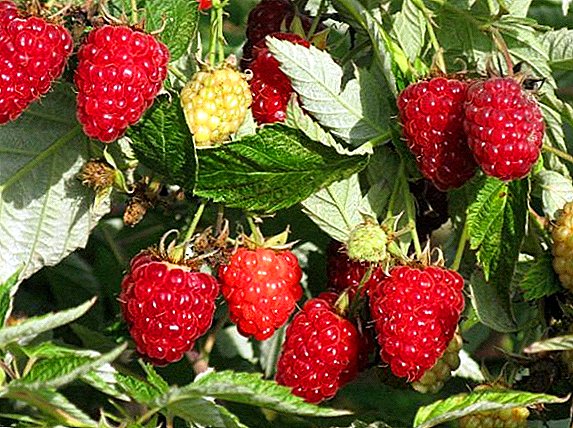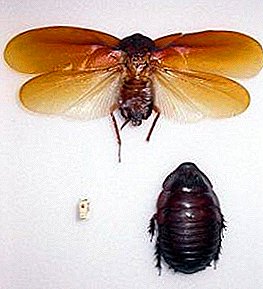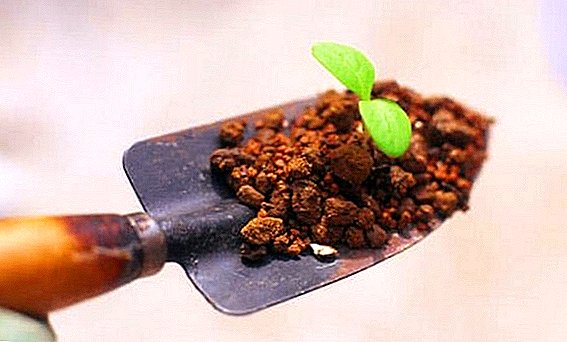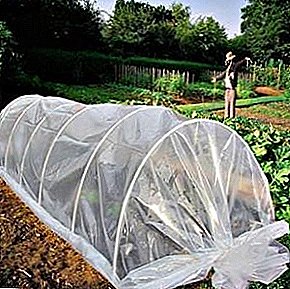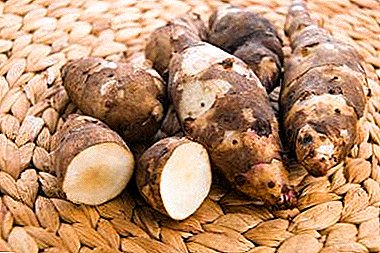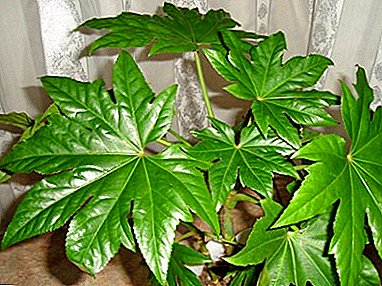
Fatsia - It is a fast-growing evergreen plant that lives in the tropical regions of the Far East - Japan, China, Korea.
At the same time, of all the diversity of species in homes and offices, only Japanese Fatsia (Aralia) - shrub, which in the room can grow in height up to 1.5 meters and is usually used to decorate walls, pillars, interiors of large rooms.
Many people like her beautiful large leaves, up to 30 cm in size, resembling chestnut in appearance. There is a hybrid of fatsia and ivy called fatshedera.
Further in the article we will talk in more detail about the Japanese Fatsia plant: home care, photos, diseases, benefits and harms.
Home care
Fatsia - undemanding to the care of a plant that can be successfully grown even with artificial light.
Care after purchase
 In the shop need to choose a small plantwhich has not had time to grow seriously. Since Fatsia is a tropic inhabitant, the pot is wrapped in several layers of polyethylene, and the resulting “bag” is filled with warm air.
In the shop need to choose a small plantwhich has not had time to grow seriously. Since Fatsia is a tropic inhabitant, the pot is wrapped in several layers of polyethylene, and the resulting “bag” is filled with warm air.
After arriving at the apartment or office where the flower will grow, you need to endure it without removing the film, 2-3 hours to adapt to new conditions. It is advisable to view all the leaves for the presence of pests, if necessary, wash them with warm soapy water.
1.5-2 weeks later after purchase, the flower must be transplanted into a new pot, slightly larger than the previous one.
Watering
Japanese Fatsia (Aralia) likes abundant watering and moist land. However, the flower will react negatively both to overdrying the earthen coma - the leaves will immediately fall on it, and to excessive watering - the shoots will turn yellow and the roots rot. Fallen from the lack of moisture leaves is quite difficult to return to its original appearance.
Spring-Summer Period The procedure is carried out when the upper part of the soil is dried, separated by soft water. With the onset of autumn, the volume of water is somewhat reduced, gradually reducing to winter. But even at this time, aridity cannot be allowed.
After watering the excess water from the pallet the pot is drained.
Bloom
In an apartment or office blooms very rarely - at the shoots at the ends appear small flowers with petals of white or yellow-green color, forming inflorescences in the form of umbrellas. Then there are berries of dark blue.
Crown formation
Japanese Fatsia (Aralia) responds well to pruning, and for the formation of a dense and lush crown, it is necessary to carry out this procedure regularly. To stimulate branching need to pinch the tips of young shoots on young plants.
Soil
Plant nutrient rich soil needed, but it can grow in standard universal mixes purchased in the store.
You can also mix the substrate yourself, for this you need to take 2 parts of sod land and 1 part of leafy earth and sand. Acidity should be slightly acidic (5.0-6.0) or normal (6.0-7.0).
Planting and transplanting
 Fatsia Japanese changes every year in spring provided that the roots completely filled the previous container (appeared from the drainage holes).
Fatsia Japanese changes every year in spring provided that the roots completely filled the previous container (appeared from the drainage holes).
New pot selected 3-5 centimeters more than the previous one, the best clay and with holes at the bottom.
Not recommended buy a pot with light walls - it will reflect the sun's rays and supercool the soil.
At the bottom of the pot, about a third of the volume, filled with drainage claydite or broken brick. For transplanting the plant is pulled out of the tank, the old earth is partially shaken off. The roots are checked for rotten and dry, if there are any, they are carefully removed, and the cut points are rubbed with coal.
The sap of the plant can cause allergies when it comes in contact with the skin - it is advisable to use gloves when transplanting, and then wash your hands well with soap and water.
Breeding
Reproduction occurs in two ways: cuttings or tap.
 Reproduction using cuttings spend spring, cutting off the apical part of the shoots with 2-3 buds.
Reproduction using cuttings spend spring, cutting off the apical part of the shoots with 2-3 buds.
The resulting cutting is placed in a wet substrate of sand and peat, with an air temperature of 23-27 degrees, where it is rooted quickly. To achieve the best effect, you can cover it with a jar on top.
After the young shoots take root, they are seated in separate pots with a full substrate. Grown flower will be low, but very thick and branchy.
Breeding by tap it is used when the lower part of the stem of the plant for any reason has lost its leaves. To do this, in the spring, an incision is made on the trunk, wet moss is placed on it and everything is wrapped with polyethylene on top.
Moss needs to be kept wet, you can sometimes soak it with phytohormone. After 1-2 months, roots will appear at the site of the cut, after which another 1-2 months wait and cut the stem of the plant just below the place where the roots were formed.
The resulting flower is transplanted into a separate pot.
The remaining stump can be trimmed and covered with moss - after a while, due to watering, young shoots may reappear from it.
Growing up
How to grow a Japanese fatsia (samurai) seed? Growing from seed is a time consuming process and is very difficult at home.
Seeds are best obtained from wild plants., while the flowering period was to take place in healthy conditions. After collection, they are stored in a dark, cold place.
Before landing all seeds are thrown into the water, and use only those that lay on the bottom. Planting is carried out in boxes of wood with drainage holes to a depth of 1 centimeter, in a mixture of equal amounts of sand, sheet and turf soil. After the shoot, the grown shoots are transplanted into individual pots of 9-11 centimeters in size.
Temperature
Best temperature Air for Japanese Fatsia in spring and summer - +20 degrees, can be exposed to fresh air in a shady place. In winter, the flower is best placed in a room with a temperature of + 10-14 degrees.
If this mode cannot be createdThen it is necessary to provide the plant with additional illumination with fluorescent lamps.
Benefit and harm
The leaves of the plant contain many nutrients, alkaloids, essential oils.
In folk medicine, they are often used as a stimulant and tonic that enhances the immunity of the body. The root can be used to treat and prevent diabetes.
At the same time, fatsia juice causes an allergic reaction when it comes into contact with the skin - redness, itching and burning. It is best to work with a plant with rubber gloves.
Scientific name
Latin name - Fatsia japonica.
Photo
Fatsia Japanese: photos of this species of azaleas.



Diseases and pests
The main pest that occurs in Japanese fatsia is shield. When infected, brown leaves appear on the leaves and stems, due to which the plant loses its brightness and the shoots fade and fall off. To fight it is necessary to wash the leaves with a brush or sponge with soapy water. You can then treat the plant with insecticides.
One more problem - spider mite, which can be determined by the presence of whitish web on the leaves. To combat it, the leaves are washed with a sponge with soapy water.
There has been a gulf of soil, it may appear gray rot - bloom on the lower part of the stem of a gray, sometimes brown shade. If this happens, it is necessary to urgently transplant with complete removal of the old earth and pruning the dead roots. In disrepair, the flower usually dies without the possibility of resuscitation.
Conclusion
Fatsia Japanese or Aralia - a popular houseplant that does not require serious care. It grows quickly, attracting the original form of leaves.
It blooms rarely, propagated by cutting or cutting off. The stem of the plant contains poisonous juice, which can cause allergies when it comes into contact with human skin.




